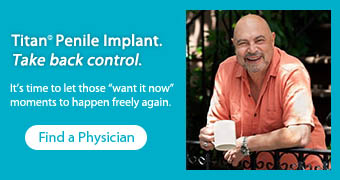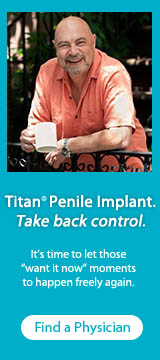https://comphya.com/product/
Hey men. What do u think about this produc?
A new alternative for ED?
Re: A new alternative for ED?
Fascinating stuff!
They claim the device is reversible and clinical trials will start next year. Let's wait and see.
They claim the device is reversible and clinical trials will start next year. Let's wait and see.
Age 40. Psychogenic ED for over 20 years. Current regimen: Udenafil 200 mg, oral phentolamine mesylate 40 mg, Seredyn.
Re: A new alternative for ED?
It sounds like the product I did the phone interview for. Reversible sounds nice.
R.R.P 2011 Mayo Jacksonville, Dr. M. Wehle. Not nerve sparing. C in margins. Radiation 2023, V.E.D, Viagra and PGE-1 (80mcg/ml) injections @ 8 - 14 units. Originally Edex20, then compounded PGE due to cost. Inject. 12 yrs. It works. Treasure coast of FL.
Re: A new alternative for ED?
So it stimulates the nerves to make an erection but is not an implant correct? Other than the stimulation device. This sounds interesting. I wander how soon something like this would be available? Also do you stay erect as long as it’s switched to on?
Re: A new alternative for ED?
Just what we need , another idea to cure ED that takes months for approval then takes years and years. I can be a new Gel or this. Just keep on waiting for approval.
Inplanted 12-28-21 USC Doctor Loh-Doyle AMS700 with MS Pump
Re: A new alternative for ED?
Get President Trump to put it in his "warp speed" program.
Married 50+ years, 75, ED for 10 years.
Dr Mark Allen, Plano, TX. Surgery at Baylor, Scott and White Frisco, TX. AMS 700 CX MS, 24 cm + 2 cm RTEs x 2.4 cm tubes, 100 ml reservoir.
4 grandkids (son 25, daughter 23, son 21, daughter 7).
Dr Mark Allen, Plano, TX. Surgery at Baylor, Scott and White Frisco, TX. AMS 700 CX MS, 24 cm + 2 cm RTEs x 2.4 cm tubes, 100 ml reservoir.
4 grandkids (son 25, daughter 23, son 21, daughter 7).
Re: A new alternative for ED?
ventura wrote:Just what we need , another idea to cure ED that takes months for approval then takes years and years. I can be a new Gel or this. Just keep on waiting for approval.
That's true but some countries are quicker than others and globalization makes things easier for us.
If this device is as good as it seems, I wouldn't hesitate to book a flight to Japan or Russia and get this.
Age 40. Psychogenic ED for over 20 years. Current regimen: Udenafil 200 mg, oral phentolamine mesylate 40 mg, Seredyn.
-
Lost Sheep
- Posts: 6162
- Joined: Mon Jul 04, 2016 11:16 pm
Re: A new alternative for ED?
Interesting.
I had the same idea over 30 years ago. Not an implant but just an electrode one could insert in the anus to stimulate the prostate. Just a speculation, really, but here we are in 2020. I mentioned it in this thread a little while ago, too. viewtopic.php?f=16&t=15294&p=135929#p135929
I have a history of inventions that I thought of and never built a prototype or investigated thoroughly that someone else brings to fruition.
I looked up the article and found it here:
https://www.jsm.jsexmed.org/article/S1743-6095(18)31165-2/fulltext
and clipped this from the web page.
Abstract
Introduction
Many studies have shown that electrostimulation of the cavernosal nerve can induce and maintain penile erection. Based on these discoveries, neurostimulation to activate the erectile response has been considered a potential solution to treat erectile dysfunction (ED). However, despite recognized potential, this technology has not been further developed. The barrier is the complex anatomy of the human cavernous nerve, which challenges the intraoperative identification of the cavernosal nerves for electrode placement.
Aim
To overcome this major barrier, we proposed a practical solution: a 2-dimensional flexible electrode array that can cover the entire plexus area, ensuring that at least 1 of the electrodes will be in optimal contact with the cavernosal nerve, without the need of intraoperative identification. The present study aims to evaluate this concept intraoperatively.
Methods
24 patients enrolled for open radical prostatectomy were recruited. During the surgical procedures, the electrode array was positioned on the pelvic plexus (on the prostatic apex or pelvic wall) and electrical stimulation was applied to induce penile erection. Penile erectile response was assessed by (i) visual change of penile tumescence and (ii) by a penile plethysmograph system.
Main Outcome Measure
Ability and success rate of evoking penile response were measured by applying electrical stimulation using the developed electrode array.
Results
Electrical stimulation produced immediate penile response in all cases when tested before (on prostatic apex) or after prostate removal (on pelvic wall). Clear visual penile engorgement was observed in 75% of the cases, whereas 25% showed minimal to moderate penile tumescence. As expected, patients with lower International Index of Erectile Function-5 score presented a reduced response, whereas stimulation before prostate removal showed greater response than following removal. Interestingly, erectile response was potentiated by bilateral stimulation (circumference increase [mm]: 2.7 ± 1.02 vs. 8.2 ± 1.9, P = .01).
Clinical Implications
These data bring sufficient proof of concept of a conceivable novel medical implant for the treatment of ED caused by mechanical nerve injury, such as prostatectomy and spinal cord injury.
Strength & Limitations
This is the first approach that can ensure the optimal site stimulation of the erectogenic neuronal path within the lower pelvic area and overcome the major barrier of individual anatomic variability. However, because this study was performed intraoperatively in an acute scenario, further studies are needed to evaluate its chronic efficacy for clinical practice.
Conclusion
The flexible electrode array concept can ensure the electrostimulation of erectogenic neuronal path when positioned on the prostate apex or pelvic floor.
Skoufias S, Sturny M, Fraga-Silva R, et al. Novel concept enabling an old idea: A flexible electrode array to treat neurogenic erectile dysfunction. J Sex Med 2018;15:1558–1569.
Key Words
Electrode Array
Erectile Dysfunction
Neuromodulation
Neurostimulation
Postprostatectomy
Spinal Cord Injury
I had the same idea over 30 years ago. Not an implant but just an electrode one could insert in the anus to stimulate the prostate. Just a speculation, really, but here we are in 2020. I mentioned it in this thread a little while ago, too. viewtopic.php?f=16&t=15294&p=135929#p135929
I have a history of inventions that I thought of and never built a prototype or investigated thoroughly that someone else brings to fruition.
I looked up the article and found it here:
https://www.jsm.jsexmed.org/article/S1743-6095(18)31165-2/fulltext
and clipped this from the web page.
Abstract
Introduction
Many studies have shown that electrostimulation of the cavernosal nerve can induce and maintain penile erection. Based on these discoveries, neurostimulation to activate the erectile response has been considered a potential solution to treat erectile dysfunction (ED). However, despite recognized potential, this technology has not been further developed. The barrier is the complex anatomy of the human cavernous nerve, which challenges the intraoperative identification of the cavernosal nerves for electrode placement.
Aim
To overcome this major barrier, we proposed a practical solution: a 2-dimensional flexible electrode array that can cover the entire plexus area, ensuring that at least 1 of the electrodes will be in optimal contact with the cavernosal nerve, without the need of intraoperative identification. The present study aims to evaluate this concept intraoperatively.
Methods
24 patients enrolled for open radical prostatectomy were recruited. During the surgical procedures, the electrode array was positioned on the pelvic plexus (on the prostatic apex or pelvic wall) and electrical stimulation was applied to induce penile erection. Penile erectile response was assessed by (i) visual change of penile tumescence and (ii) by a penile plethysmograph system.
Main Outcome Measure
Ability and success rate of evoking penile response were measured by applying electrical stimulation using the developed electrode array.
Results
Electrical stimulation produced immediate penile response in all cases when tested before (on prostatic apex) or after prostate removal (on pelvic wall). Clear visual penile engorgement was observed in 75% of the cases, whereas 25% showed minimal to moderate penile tumescence. As expected, patients with lower International Index of Erectile Function-5 score presented a reduced response, whereas stimulation before prostate removal showed greater response than following removal. Interestingly, erectile response was potentiated by bilateral stimulation (circumference increase [mm]: 2.7 ± 1.02 vs. 8.2 ± 1.9, P = .01).
Clinical Implications
These data bring sufficient proof of concept of a conceivable novel medical implant for the treatment of ED caused by mechanical nerve injury, such as prostatectomy and spinal cord injury.
Strength & Limitations
This is the first approach that can ensure the optimal site stimulation of the erectogenic neuronal path within the lower pelvic area and overcome the major barrier of individual anatomic variability. However, because this study was performed intraoperatively in an acute scenario, further studies are needed to evaluate its chronic efficacy for clinical practice.
Conclusion
The flexible electrode array concept can ensure the electrostimulation of erectogenic neuronal path when positioned on the prostate apex or pelvic floor.
Skoufias S, Sturny M, Fraga-Silva R, et al. Novel concept enabling an old idea: A flexible electrode array to treat neurogenic erectile dysfunction. J Sex Med 2018;15:1558–1569.
Key Words
Electrode Array
Erectile Dysfunction
Neuromodulation
Neurostimulation
Postprostatectomy
Spinal Cord Injury
Lost Sheep
AMS LGX 18+3 Nov 6, 2017
Prostate Cancer 2023
READ OLD THREADS-ask better questions -better understand answers
Be part of your medical team
Document pre-op size-photos and written records
Pre-op VED therapy helps. Post-op is another matter
AMS LGX 18+3 Nov 6, 2017
Prostate Cancer 2023
READ OLD THREADS-ask better questions -better understand answers
Be part of your medical team
Document pre-op size-photos and written records
Pre-op VED therapy helps. Post-op is another matter
-
Lost Sheep
- Posts: 6162
- Joined: Mon Jul 04, 2016 11:16 pm
Re: A new alternative for ED?
There are several articles cited by the one in the O.P. Most of them look worthy of reading. I checked out this one so far.
Extrapelvic cavernous nerve stimulation in erectile dysfunction. Human study
https://pubmed.ncbi.nlm.nih.gov/8738078/
Extrapelvic cavernous nerve stimulation in erectile dysfunction. Human study
https://pubmed.ncbi.nlm.nih.gov/8738078/
Lost Sheep
AMS LGX 18+3 Nov 6, 2017
Prostate Cancer 2023
READ OLD THREADS-ask better questions -better understand answers
Be part of your medical team
Document pre-op size-photos and written records
Pre-op VED therapy helps. Post-op is another matter
AMS LGX 18+3 Nov 6, 2017
Prostate Cancer 2023
READ OLD THREADS-ask better questions -better understand answers
Be part of your medical team
Document pre-op size-photos and written records
Pre-op VED therapy helps. Post-op is another matter
-
wolfpacker
- Posts: 1127
- Joined: Thu Dec 12, 2013 10:16 pm
Re: A new alternative for ED?
Since it stimulates the nerves responsible for creating an erection, I don't think this will help for people with veinous leak. Rather, as it states on their website it is for those who have had prostatectomy or a spinal cord injury.
Early 30s with ED for years from penis enlargement stretching and jelqing. Implant by Dr Eid on 24 June 2021 with a Titan 24cm with +1cm RTE on one side and -1cm cut off on the other side
My journal: viewtopic.php?t=17202
My journal: viewtopic.php?t=17202
Return to “General Discussion”
Who is online
Users browsing this forum: No registered users and 39 guests






